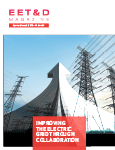The electric grid is entering an era of transition: power-generation technology is getting greener and more distributed, energy loads are denser in some areas and are more reliant on high-quality power, and customer expectations for more reliable power are rising. These changes are placing a lot of pressure on the grid and utilities all at one time.
But most power users don’t consider the complexity of the electric grid system. While the accelerated use of consumer technology has increased the density of some power loads, it has highlighted the need for improved power reliability across all loads. Consumers are no longer willing to wait for the power to come back on; in fact, they expect it never to turn off. At the same time, there is increasing pressure from the public and policymakers to reduce the harmful climate impacts of our energy systems.
These simultaneous pressures of an increasingly complex system with higher customer expectations and the need to reduce carbon footprints are now joined by our need to focus on economic recovery from the COVID-19 pandemic crisis. Businesses globally are attempting to claw their way back to productivity, and reliable energy is going to be an important ingredient for success. Utilities and regulators alike are trying to be creative in how they solve these challenges.
There is good news, though. There are expectations that the lights must stay on, and distributed energy resources (DERs) can help ensure that happens. There is also growing consensus in the industry that we need a cleaner grid and that a reliable grid is going to be absolutely critical to deliver cleaner energy.
Increased use in green generation is changing the grid
Some of the most common DERs being integrated into the grid are “green” generation sources such as solar panels and wind turbines. The addition of these carbon-free generation sources can provide immense benefits to the grid, but they come with their own set of challenges.
DERs can help diversify a utility’s total energy supply, thereby building up a utility’s overall resilience. The use of DERs also provides an alternative to fossil fuels, reducing greenhouse gas emissions to achieve carbon-footprint goals outlined by governments and businesses. With so many organizations increasing their focus on corporate sustainability efforts, having green energy generation is becoming increasingly important.
From a financial perspective, DERs make sense for a utility’s bottom line. When compared to developing a traditional generation plant or substation to support increased demand, DER integration is often much more affordable for utilities and their customers.
It’s hard to argue with the benefits of green generation: help save the planet while saving money. But the actual installation of these DERs isn’t as simple as plugging in a solar panel. It’s important to remember the grid wasn’t designed for this. For the last century, the grid has operated as a one-way power-delivery system. Power plants were located at one end of the grid, and customers were at the other. Today, DERs enable power to enter the grid at a variety of locations, which is changing the architecture of the grid. Most green generation is being added directly to the distribution system, which isn’t designed to optimize these distributed sources, and it is delivering electricity to the parts of the distribution grid where it’s needed most.
The grid is changing from a one-way power-delivery system to a distributed electricity network, facilitating generation and loads in any direction. When left unchecked, this shift in power flow can pose significant risks for existing grid equipment and line crews. Before utilities can fully embrace DERs to help support generation needs and customer demand, other aspects of the grid and overall utility operations must be updated to better accommodate this change. When done correctly, the installation of DERs can improve a grid’s reliance and reliability.
Areas of consideration before integrating green generation sources
Technical grid solutions
A critical area of consideration for any utility before adding DERs to its system is to evaluate and modernize the existing distribution grid. As the future home of new DERs, distribution systems require advanced grid solutions to help ensure all aspects of the system are protected and ready to accommodate these new generation assets.
One way to bolster lateral lines in preparation for DER integration is to increase grid segmentation. Adding more protective switching devices throughout the system and segmenting lateral lines into smaller pieces allows utilities to achieve higher levels of configuration. This enables utilities to integrate more DERs safely and effectively into the system while simultaneously reducing unnecessary outages. When segmentation is paired with smarter controls serving both the transmission and distribution grids, it allows utilities to efficiently balance loads and resources across their service territories.
Changes to regulation policy
Modernizing an existing distribution system requires a significant utility financial commitment, and sweeping changes are often not possible without the support of state regulators. To encourage utilities to make these grid changes to support DER growth, a shift in how regulatory bodies and policies measure a utility’s overall performance will likely be required.
For decades, utilities have navigated a cost-of-service model, which rewards utilities with a rate of return for their investments. The safest way utilities can get those returns approved has been to stick with traditional, well-known technologies that essentially involve rebuilding the grid of the past. The single-year rate cases and risk-averse investment methodology has meant transformative investments in the grid were almost impossible. Given all the changes discussed earlier, this kind of regulation isn’t likely to result in the green, reliable grid of the future.
A solution some states and several other countries are trying is performance-based regulation (PBR). PBR helps utilities to invest in changes they need for an advanced grid by allowing for longer rate periods and financial benefits tied to outcomes instead of earning a simple rate of return on legacy investments.
PBR can also incorporate more advanced reliability metrics. All of this allows regulators to better understand company performance to incentivize outcomes that are truly in the public interest. Many states are exploring PBR business models, and those using them are seeing great improvements throughout their local grids. The more effort a utility puts into improving its performance, the greater the reward.
The use of new metrics
Also important is for utilities to begin expanding their measurement tactics to include more than System Average Interruption Duration Index (SAIDI) and System Average Interruption Frequency Index (SAIFI). These average systemwide performance metrics are where many utilities focus their attention, but they create a disconnect between what a utility’s perceived reliability is and what utility customers are actually experiencing. The increasing complexity of the energy grid may make acute problems on the grid worse if the right solutions aren’t in place. As DER integration grows, utilities must consider reliability metrics that better capture customer experience.
DER performance is not captured in traditional utility metrics to gauge performance, but for DERs to be impactful the grid must be reliable. Without a bedrock of grid reliability, utilities will find it challenging to effectively integrate DERs as supplemental generation options. The inclusion of more customer-centric metrics can provide a more complete picture of overall reliability. Metrics such as Customers Experiencing Multiple Interruptions (CEMI) and Customers Experiencing Multiple Momentaries (CEMM) help paint a more complete picture.
During the transition with DER integration, ensuring grid performance is meeting customers’ expectations will be crucial to overall utility success. It may also be necessary for the electric utility industry to develop new performance metrics more focused on resilience and stability to help better gauge overall performance and areas for improvement.
The frequency of DER deployment on the grid will continue to grow, but to make this transition to greener generation sources as smooth as possible, the grid must be in a position to support these new resources. We can’t have a green grid unless we are willing to invest in a reliable one.
 Brian Levite is the regulatory affairs director at S&C Electric Company. He joined S&C from Hitachi, where he helped develop the company’s microgrid offering. Prior to Hitachi, Levite worked at the National Renewable Energy Lab, the Department of Energy and the Environmental Protection Agency, developing and implementing government programs focused on energy efficiency and renewable energy. Levite earned a master’s in public policy at American University and is a Certified Energy Manager. He is the author of the book Energy Resilient Buildings and Communities: A Practical Guide.
Brian Levite is the regulatory affairs director at S&C Electric Company. He joined S&C from Hitachi, where he helped develop the company’s microgrid offering. Prior to Hitachi, Levite worked at the National Renewable Energy Lab, the Department of Energy and the Environmental Protection Agency, developing and implementing government programs focused on energy efficiency and renewable energy. Levite earned a master’s in public policy at American University and is a Certified Energy Manager. He is the author of the book Energy Resilient Buildings and Communities: A Practical Guide.







